Battle
Following an attempted push back to Port-de-Paix, British General John Whitelocke decides to attack the Fortress of Acul, located a league from the town of Léogâne. The 13th, 20th, 49th and 62nd British regiments, composed of European soldiers, land in this city and then march the fort. The latter was stormed after a three-hour battle during which Baron de Montalembert, Colonel Spencer, Captain Vincent, the elite companies of the 49th and the light infantry of the Royal Guards and 49th. A young black Republican, however, fires in the powder keg of the fort which causes an explosion that kills 60 English soldiers.
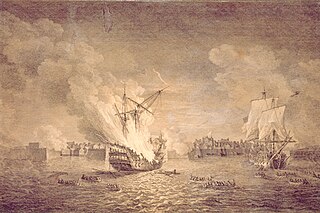
1758 (MDCCLVIII) was a common year starting on Sunday of the Gregorian calendar and a common year starting on Thursday of the Julian calendar, the 1758th year of the Common Era (CE) and Anno Domini (AD) designations, the 758th year of the 2nd millennium, the 58th year of the 18th century, and the 9th year of the 1750s decade. As of the start of 1758, the Gregorian calendar was 11 days ahead of the Julian calendar, which remained in localized use until 1923.

Major-General Sir Isaac Brock KB was a British Army officer and colonial administrator from Guernsey. Brock was assigned to Lower Canada in 1802. Despite facing desertions and near-mutinies, he commanded his regiment in Upper Canada successfully for many years. He was promoted to major general, and became responsible for defending Upper Canada against the United States. While many in Canada and Britain believed war could be averted, Brock began to ready the army and militia for what was to come. When the War of 1812 broke out, the populace was prepared, and quick victories at Fort Mackinac and Detroit defeated American invasion efforts.

Henri Christophe was a key leader in the Haitian Revolution and the only monarch of the Kingdom of Haiti.

Jean-Jacques Dessalines was a leader of the Haitian Revolution and the first ruler of an independent Haiti under the 1805 constitution. Under Dessalines, Haiti became the first country to permanently abolish slavery. Initially regarded as governor-general, Dessalines was later named Emperor of Haiti as Jacques I (1804–1806) by generals of the Haitian Revolution Army and ruled in that capacity until being assassinated in 1806. He has been referred to as the father of the nation of Haiti.

The Haitian Revolution was a successful insurrection by self-liberated slaves against French colonial rule in Saint-Domingue, now the sovereign state of Haiti. The revolt began on 22 August 1791, and ended in 1804 with the former colony's independence. It involved black, biracial, French, Spanish, British, and Polish participants—with the ex-slave Toussaint Louverture emerging as Haiti's most charismatic hero. The revolution was the only slave uprising that led to the founding of a state which was both free from slavery and ruled by non-whites and former captives. It is now widely seen as a defining moment in the history of the Atlantic World.

Fort-Liberté is a commune and administrative capital of the Nord-Est department of Haiti. It is close to the border of the Dominican Republic and is one of the oldest cities in the country. Haiti's independence was proclaimed here on November 29, 1803.
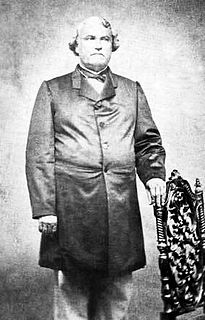
Thomas Madiou was a Haitian historian. His work Histoire d'Haïti is the first complete history of Haiti from 1492 to 1846. It is considered one of the most valuable documents of Haitian history and literature.
Acul-du-Nord is a commune in the Acul-du-Nord Arrondissement, in the Nord department of Haiti.
Limbé is a commune in the Limbé Arrondissement, in the Nord department of Haiti.
Acul-du-Nord is an arrondissement of the Nord department of Haiti. As of 2015, the population was 129,155 inhabitants. Postal codes in the Acul-du-Nord Arrondissement start with the number 12.

The invasion of Martinique was a successful British amphibious operation against the French colony of Martinique that took place between 30 January and 24 February 1809 during the West Indies campaign of 1804–1810 of the Napoleonic Wars. Martinique, like the nearby island of Guadeloupe, was a major threat to Britain's trade in the West Indies, providing a sheltered base from which privateers and French Navy warships could raid British merchant shipping and disrupt the trade routes that maintained the economy of the United Kingdom. Both islands also provided a focus for larger-scale French operations in the region and in the autumn of 1808, following the Spanish alliance with Britain, the Admiralty decided to order a British squadron to neutralise the threat, beginning with Martinique.
Suzanne Bélair, called Sanite Bélair,, was a Haitian revolutionary and lieutenant in the army of Toussaint Louverture.
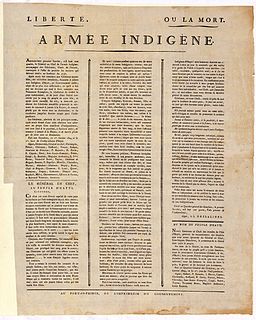
The Haitian Declaration of Independence was proclaimed on 1 January 1804 in the port city of Gonaïves by Jean-Jacques Dessalines, marking the end of 13-year long Haitian Revolution. The declaration marked Haiti's becoming the first independent nation of Latin America and only the second in the Americas after the United States.

The Capture of Fort-Dauphin was a bloodless encounter of the French Revolutionary Wars on which a Spanish expedition under Gabriel de Aristizábal seized Fort-Liberté, then named Fort-Dauphin, from Revolutionary France. The French colonial garrisons, consisting of over a thousand men, surrendered without firing a single shot.
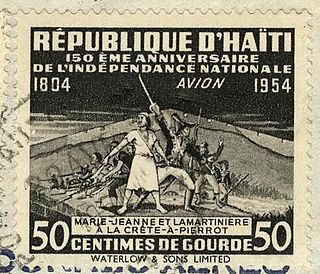
Marie-Jeanne Lamartinière, known in history only as "Marie-Jeanne", was a Haitian soldier, and reportedly a "dazzling beauty." She served in the Haitian army during the Haitian Revolution (1791–1804).
The siege of Port-au-Prince took place during the Haitian Revolution.
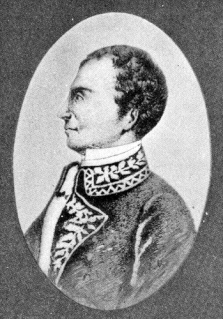
The Battle of Croix-des-Bouquets took place during the Haitian Revolution.
The Battle of Saint-Raphaël took place during the Haitian Revolution.

The Battle of Cap-Français took place from 20 to 22 June 1793 during the Haitian Revolution.
The Battle of Port-Républicain took place during the Haitian Revolution (1791-1804).
This page is based on this
Wikipedia article Text is available under the
CC BY-SA 4.0 license; additional terms may apply.
Images, videos and audio are available under their respective licenses.











